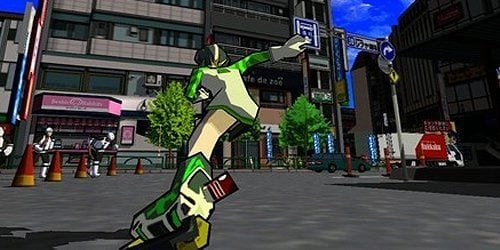
Jet Set Radio is a cult classic of the Sega Dreamcast console, and rightfully so. It’s the kind of game that’s easy to look back on fondly, through the rose-tinted glasses of nostalgia. It’s easy to only remember the colorful world and catchy music, the things that can be sold and resold through trailers and screenshots. You probably don’t remember the horrible controls, frustrating physics, and awful camera because, if you’re lucky, your mind will have repressed memories of them.
What Jet Set Radio does well, it does really well. The cel-shaded art style translates wonderfully to high definition. This is a world made of solid, bright colors, and sharp angles, giving everything a very clear outline. Even though the textures themselves aren’t updated (everyone has a flat face), the rest of the game is so stylized that the blocky characters become endearing. Jet Set Radio stands as a testament to how good art can future-proof a game: It still looks great, even 12(!) years later.
The music is also excellent, filled with hip-hop and funk beats that are so catchy you’ll find yourself humming them days later. The music and art match perfectly. Whenever a new gang is introduced, they’re always shown dancing in unison, and it’s hard not to feel happy in that moment: watching these vibrant characters dancing to awesome music.
Unfortunately, the gameplay kills all that happy charm.
You skate around a small, open level collecting spray cans, then use those spray cans to paint graffiti on specific targets. All the while, you’re outrunning a totalitarian police force, assassins, tanks, and helicopters, all hell bent on stopping you. The painting controls are surprisingly fun. You’ll perform a series of flicks and twists with the control stick that mimic the movement of tagging a wall. It’s simple, intuitive, evocative, and since the exact movements don’t change you can quickly become very good at it.
But getting to those graffiti targets is where the game falls apart. Jet Set Radio has awful controls. Since you’re always on roller skates your immediate range of movement is limited. You can’t turn on a dime thanks to your momentum, so every time you miss a target, you have to take a wide u-turn to come back around. Since momentum matters so much, missing a jump doesn’t just mean reorienting yourself for a second try but also giving yourself enough room for a running start. And you have to do this while being hammered with gunfire and missiles from cops and helicopters that knock you down, forcing you to start over yet again. The fact that your character takes so long to recover from being knocked over, giving all your enemies time to swarm over you, just drives the knife deeper.
The controls get even worse once your feet leave the ground. You jump like you’re on the moon. It’s a very slow, floaty arc, but with very little air control. This means you can’t be precise. When leaping across rooftops from one rail to another, you can’t position yourself midair to fine tune your landing — where you land is determined as soon you leave the ground. Most of the time you’re just working based on gut or luck, which means you’ll miss a lot of jumps, which means taking a long, circuitous route just to get back into position to try again.
For a game that requires precision platforming, the imprecise controls are mind boggling. They’re a constant source of irritation, they’re never comfortable and never helpful, and they’re something you have to fight every small step of your way through this game. At best, they’re merely unobtrusive; at worst, the imprecision will make you want to snap your controller in half.
It’s unfortunate that the basic controls are so frustrating because the levels aren’t that hard. They’re always small, but just big enough to encourage and reward exploration. Most of the graffiti targets are easy to reach, but the final target is inevitably hidden away in a hard to reach place, requiring you to jump, grind, or trick up to some faraway ledge.
The camera doesn’t help any. While you can at least control the camera this time (the Dreamcast controller only had one control stick), it’s too sensitive, and you can’t change this setting: You’ll constantly spin it too far when you try to use it, which means that the camera spends most of its time fidgeting in every direction. Even worse, the “spray” button is the same as the “center camera” button, so whenever you come to a graffiti target and start mashing the button to tag it as fast as possible (because you are being chased by police), the camera spasms back and forth, making you lose all sense of direction. It’s very disorienting, and considering that this HD re-release already added a whole new method of camera control, there’s no excuse for this awful control scheme to remain.
In another 12 years when a Super HD remake comes out, Sega will sell Jet Set Radio based on more trailers and screenshots, and it’ll look just as slick then as it does now. It’ll also play just as poorly.

![Call for Papers: All Things Reconsidered [MUSIC] May-August 2024](https://www.popmatters.com/wp-content/uploads/2024/04/all-things-reconsidered-call-music-may-2024-720x380.jpg)



